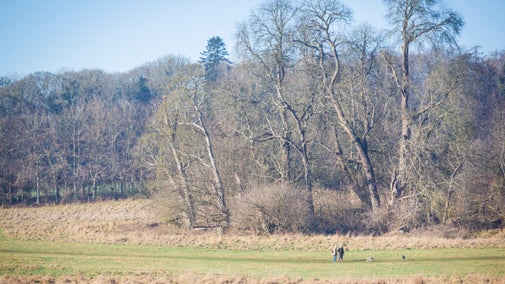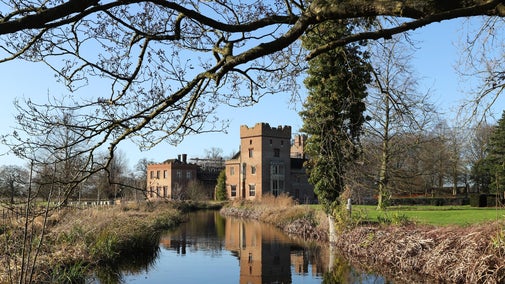
Donate
Everyone needs nature, now more than ever. Donate today and you could help people and nature to thrive at the places we care for.

Mottisfont’s woodlands, along with the River Test which flows through the estate, can provide habitats for a large variety of wildlife. The work we do on the estate aims to make these environments as wildlife-rich as possible.
We care for 5 miles of the world-renowned River Test and its tributaries. It has shaped the Mottisfont estate for centuries, binding the history of the house and its people to the landscape. Mottisfont even has a celebrated past as the birthplace of modern dry fly fishing.
The River Test is a Site of Special Scientific Interest (SSSI). Only 200 chalk stream rivers are known globally - and 85% of them are found in southern and eastern England. Yet many are currently in poor condition. Climate change, pollution and intensive management place our river habitats under severe threat. It’s currently predicted that salmon may be extinct in the UK within the next 50 years.
We're changing our approach in the way we look after this vital habitat, taking preventative action against further decline. We're focused on improving habitat quality and diversity by restoring river banks to a more natural profile and improving water flow. This will create more favourable habitats for wild fish, birds, and mammals, including the iconic kingfisher.
We're transitioning to a wild fishery model which will honour our cultural heritage while giving priority to the global importance of this unique habitat.
We manage Mottisfont's woodlands to make them as wildlife-rich as possible. Most of this conservation work is carried out by rangers in autumn and winter. And it's not just the woodland, but the edges, open spaces and network of ‘rides’ too – the grassy paths you’ll find in and around woods.

The vegetation in these areas are often the most ecologically diverse and they attract a huge variety of wildlife. In fact, the first 10 metres of any woodland edge can be home to more species than the rest of the woodland in its entirety. These rides also act as vital ‘wildlife corridors’ for animals – in particular bats.
The Mottisfont estate is part of the Bat Conservation Trust’s national monitoring programme (NBMP). In 2003 the woodlands here were designated a Special Area of Conservation for rare barbastelle bat maternity roosts – one of only six known UK breeding sites at the time.
We carry out barbastelle bat surveys between July and September, along three known wildlife corridors on the estate. We're also working to protect eight other species that have been recorded at Mottisfont, including noctules and brown long-eared bats.
Individual trees are also surveyed, for features that indicate their potential as a bat roost. This could be woodpecker holes, branch splits, a hollow section, or dense ivy cover. We sometimes use aerial surveys, too, and an endoscope to look for cavities invisible from the outside.
Trees with no bat activity but which are favourable in other ways may be considered for monolithing (cut back to the trunk) or a crown reduction. This is done by an experienced arborist, who creates cuts that imitate natural damage, providing favourable conditions for all sorts of wildlife.

Other trees may be ring-barked to encourage dead wood – an important part of a woodland’s ecological process. A small number of low conservation value trees might be felled to help maintain the wildlife corridors.
These techniques don’t just provide more wildlife habitats, they break up the canopy cover and introduce more light along the ride edge. This encourages ground flora, which in turn attracts invertebrates like bees, hoverflies and butterflies.
Ranger Ryan Scott says: 'It’s really important that the various landscapes within woodlands support each other. For example, we need to make sure that tree-dwelling mammals like dormice have connectivity between the different woodland ‘compartments’ and don’t become isolated.
'We aim to create a mix of habitats; grassy swards and ‘herby’ edges, scrub and coppice areas. One of the ways we do this is by cutting on rotation. This is carried out in winter when the trees are dormant, so that we cause the least disturbance to wildlife.'

Everyone needs nature, now more than ever. Donate today and you could help people and nature to thrive at the places we care for.
Explore Mottisfont’s diverse estate, criss-crossed by the crystal-clear River Test, and south Hampshire countryside sites of Stockbridge Down and Marsh and Curbridge Nature Reserve.

We’re doing lots of work to look after the countryside sites of Stockbridge Down, Stockbridge Marsh and Curbridge Nature Reserve in order to provide key habitats for rare species.

We make compost in vast quantities at Mottisfont, keeping the soil healthy and ensuring the garden, including the famous rose collection, is looking its very best.

Find out how you could join us - whether you're looking to make new friends, develop skills or simply want to be part of something you're passionate about.

Mottisfont offers a fantastic family day out, with something for everyone. As well as the wild play area, scenic river and meadow, there are specially-designed activities for pre-schoolers and exciting events every school holiday. Enjoy perfect winter picnic spots, delicious treats from our cafés, and convenient baby-changing facilities - all in a beautiful, welcoming environment.

We believe that nature, beauty and history are for everyone. That’s why we’re supporting wildlife, protecting historic sites and more. Find out about our work.

Read about our strategy, which focuses on restoring nature, ending unequal access and inspiring more people.
